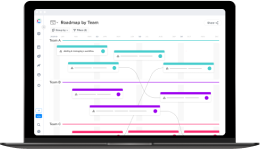Home > Blog > Product Owner vs. Product Manager
Product Owner vs. Product Manager

Seeking for the right product manager role, many people are confused by the variety of similar deceptive requirements, descriptions and expectations from the product owners, they find in various organizations. No wonder, some of them overlap, indeed. However, it’s rather the inability of the managerial culture to adopt, adjust and reflect the right roles for either a product owner or a product manager that makes things complicated. There is no single standard yet, but let’s sort things out.
Product Manager Role vs. Product Owner Roles
Surprisingly, there are so many seeming product management homonyms that one can hardly keep his head cool: Business Analyst, Product Leader, Product Designer, Product Engineer, Program Manager, Product Marketer and so on. Unlike this, the term ‘product owner’ has more or less clear definitions and expectations, mostly due to its closeness to agile/scrum practices.
Despite the fact that product owner and product manager roles and responsibilities are as amorphous or blurred as the product management itself, people should have some idea of how to distinguish these two roles for better performance.

Product Owner as Related to Scrum
The historical backdrop of the product ownership is firmly identified with the scrum innovation. In agile or scrum development, the group more often comprises of 5-9 resources or colleagues. All of them work back to back to meet the team members’ commitments. Since the group is attempting to 100% meet their duties, scrum permits the resource that is called ‘Scrum expert’ or ‘Scrum master’ to encourage the day by day or week after week meet-ups and play out the part of a battering ram thumping down any of the obstructs that are the impediments in meeting the common individuals’ responsibilities. Anyway, how the scrum characterizes what responsibilities to do or what issues to settle? This is the thing that product owner does and his or her part is totally characterized by the connections in the scrum group.
Thus, the major responsibility of a product owner as a resource with the market knowledge and ample user will be:
- identifying the issues to solve
- elaboration of the problems into users stories (get free user story template)
- prioritizing them into the backlog
- constant communication with the team members
- decision making
Even if it sounds like a product marketing manager responsibilities, indeed, there are still some warnings:
- First of all the product owner is characterized totally by his or her connection to the development group he or she is in, and to how they add to the achievement of that group in meeting their duties. There is nothing in the conventional meaning of a product owner that can include partners, stakeholders, technique, client interchanges, advertising, support, or any of the different worries that a product manager must have every day keeping in mind the end goal, to guarantee that the product is seen by the business sector as a profitable answer for the client needs. Product development manager responsibilities are adjusted for that. The product management major is characterized by the relationship to the business sector, while product ownership is characterized by the relationship to the improvement group.
- Secondly, there are some inborn strains between the exemplary meanings of a product ownership and a classic PM. Product owners are more likely to be expected, as noted above, by their Scrum groups to be accessible to any individual from the group any time needed. Whenever, to answer any inquiry in connection with that group’s present duties. The owner could be the biggest blocker of progress as they are not just people who characterize what anyone can do, they are likewise a definitive referee regardless if the story is “done” or “acknowledged” as done.
Undoubtedly, the role of the product owner is a key in any Agile/Scrum methodology. At the same time, expectations and definitions of this role are even more blurred than the roles of Scrum Master and Scrum Team as the whole. If we speak in metaphors, the Scrum team is a powerful (or not really) car, and how fast it goes may directly depend on the driver’s level of experience, who is the Product Owner.
In real practice, this role can be expressed as an intersection of knowledge and skills from the four PM “worlds:”
Product Manager – the person who knows what business and the users want,
Project Manager – the person who knows how to plan and monitor the implementation of the project,
Business Analyst – a person who knows how to get the requirements from users and how to prepare the requirements to the fast team performance,
The Leader – the person who knows how to direct the overall efforts in the same direction, where to focus and how to motivate the team to achieve the mutual goal.
Product Manager vs. Product Owner vs. Project Manager
Let’s pull this all together and review the key areas of responsibilities for the three often-confused roles: Product Manager, Product Owner, and Project Manager.
The Product Manager is the strategic driver of the company’s product and ultimately the person responsible for that product’s success or failure on the market.
Because the role includes such significant responsibility, and because many departments throughout the organization contribute to the product’s success, Product Managers’ duties often draw their time and attention to different areas of the company: marketing, sales, customer success, purchasing, IT, and of course development or manufacturing.
That’s why Product Managers, particularly in larger enterprises, need to keep their focus strategic and high-level — and, when possible, to offload some of the more tactical responsibilities to a Product Owner.
The Product Owner, as we’ve been explaining in this post, works more closely with the technical team — the developers in a software company, for example — and helps the people actually building the product understand the strategic reasoning or business needs behind the tasks they’re carrying out.
That’s why, as we noted above, it will be often the Product Owner who writes the user stories and prioritizes which backlog items get promoted to an upcoming sprint. In agile-focused companies —and busy organizations in general — the Product Manager often needs to delegate these more tactical responsibilities so they can focus on bigger-picture strategic projects like market research.
And although pay rates can vary among companies and industries, there is typically a similar hierarchy in terms of Product Owner vs. Product Manager salary. Because the Product Manager role is more strategic and has more direct responsibility for the company’s revenue, Product Managers are usually paid more than Product Owners.
Agile Product Manager vs. Product Owner
In case you’re wondering, no, Product Owner is not synonymous with agile Product Manager. In fact, you’re most likely to find a Product Owner in an agile company — and that company will definitely have Product Managers as well. An agile Product Manager is simply a Product Manager whose team and company take the agile approach to development: building product functionality in small increments, releasing that functionality to users, and iterating based on the market’s feedback.
Because agile Product Managers must move quickly — and spend a of time communicating with users and analyzing their feedback — they need to delegate much of the day-to-day oversight and communication with developers to their Product Owners.
Finally, a Project Manager — a role that’s often confused with both Product Owner and Product Manager — is a more general, tactical position that focuses on helping teams complete large, complex projects in the most efficient and cost-effective ways possible.
In a company that doesn’t have Product Owners, a Project Manager might fulfill some of those responsibilities — serving as a liaison between the product and development teams and making sure the developers understand the jobs they need to do and in what priority order.
But it’s worth noting that a Project Manager is a very broad role that could perform the same tasks —overseeing and shepherding large projects to completion — in any environment, not just in product management.
In fact, one of the key Product Owner vs. Project Manager distinctions is that a Product Owner is entirely product-focused and needs some expertise in both product management and development, whereas a Project Manager needs a different set of skills — including organization and time management.
For more detail on the differences between product management and project management, read our guide: The Product Management Career Path.
There are no ideal product owners who have evenly combined all four above mentioned areas. Although it is not a problem. The product owner responsibilities and roles are often considered to be mythical because they are like technical product manager responsibilities or those of a product manager, engineer or someone else. In fact, it does not matter what sphere you come from to the role of the product owner. The most important is how you learn to play the current role.
Paradoxically, the success of the project directly depends on who performs the role of the Product Owner. And here the most interesting question arises: where and how to learn to be the best product owners? There is no single answer. Of course, self-education, learning from colleagues, sharing experience, consulting and so on are extremely important ways to improve your performance as a product owner.
There are no boundaries in self-improvement via the I-net project management community, reading blogs, forums, articles, books and virtual meetups, etc. At the same time, do not forget to use specialized templates and product management tools related to a better and deeper study of this role.
Welcome with your ideas on product owner vs. product management roles, comments and shares.

